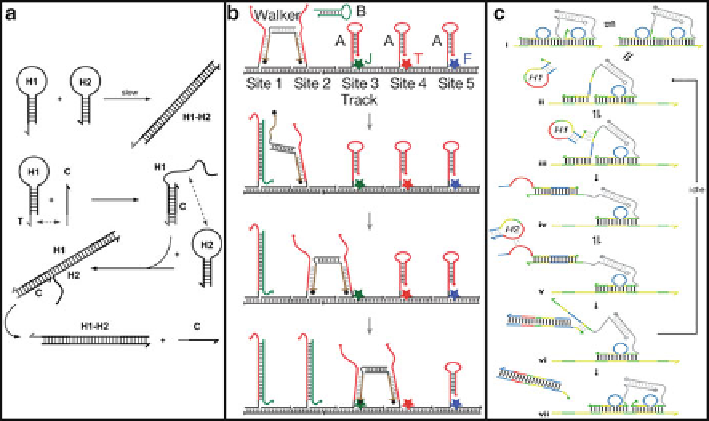Biomedical Engineering Reference
In-Depth Information
Fig. 11.10
(
a
) The principle of hybridization catalysis (Reproduced from Ref. [
64
] by permission
of John Wiley & Sons Ltd). (
b
) Secondary structure mechanism depicting processive locomotion
(Reprinted by permission from Macmillan Publishers Ltd: Ref. [
65
], copyright 2008). (
c
)Design
and motions of autonomous walker. The two-part fuel consists of complementary hairpins H1 and
H2. Competition between feet for binding to the track (
i
) can lift part of the left foot from the
track to reveal a toehold domain (
ii
). This can bind the complementary toehold domain of H1 (
iii
),
initiating a strand displacement reaction that opens the neck of H1 and displaces the left foot from
the track (
iv
). Part of the opened loop H1 can act as a second toehold to initiate hybridization
with H2 (
v
) to form a stable waste product (the H1H2 duplex), displacing H1 from all but the
initial toehold domain of the lifted foot (
vi
) and allowing the foot to rebind the track to the left or
right with equal probability (
vii
) (Reprinted with permission from Ref. [
67
]. Copyright 2008 by
American Physical Society)
of the catalyst strand C invades the H1 stems at the toehold and makes the loop
available for hybridization. Consequently, H2 can hybridize to H1 more efficiently
and displace catalyst C in the final step.
In the DNA walker systems to be discussed, the hybridization catalyst concept is
ingeniously implemented to produce unidirectional motion of the walkers. Pierce
and coworkers demonstrated a design of the autonomous walker as depicted in
Fig.
11.10
b[
65
]. The walker is a double-stranded DNA with two single-stranded
extensions at opposite sides, and the footpath is a duplex with self-closed hairpin
footholds. Initially, the walker is attached to the footpath with its two feet binding
to footholds. After the hybridization of hairpin B with the overhang segment of
the occupied foothold, one foot of the walker is released and ready to invade the
next hairpin foothold. The walker can only move forward because the previous
footholds form a full duplex. The motion of the walker was monitored by AFM
and FRET. The problem of this system is that the sequences of the walker's two feet
were the same, both of which can be released from the footholds at the same time,
resulting in the dissociation from the walker. Later, Seeman and coworkers reported

Search WWH ::

Custom Search